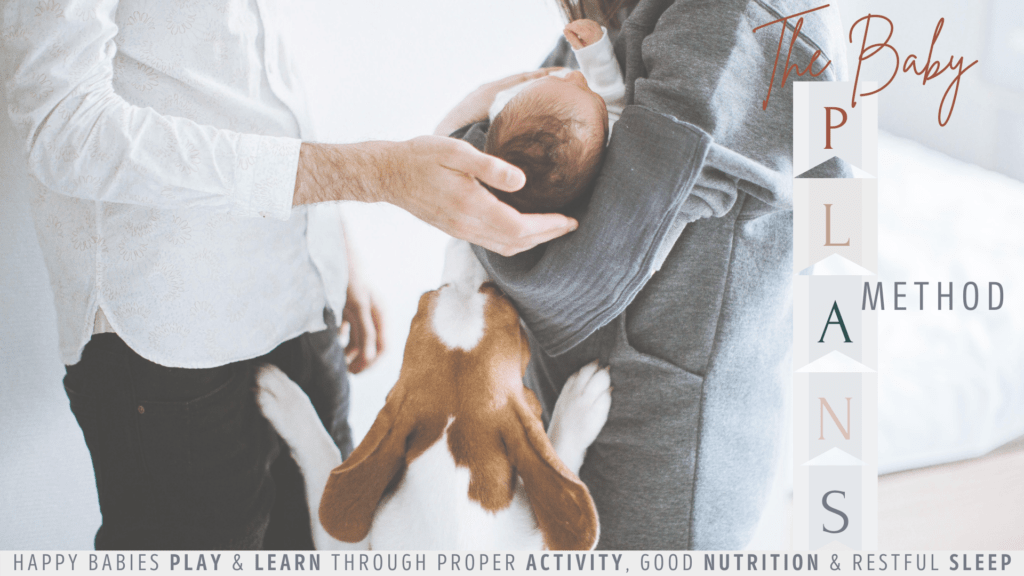This sleep series is a beneficial refresher course for me with a new baby years after my other children have outgrown the baby stage. This is a schedule of sorts that has worked for me as well as thousands of other moms worldwide; I hope you find it just as beneficial.
As your child grows, be sure to adjust their schedule accordingly using additional charts {more coming soon}.
- E.A.S.Y. DAY 4 TO WEEK 6
- E.A.S.Y. WEEK 6 TO MONTH 4
- E.A.S.Y. MONTH 4 TO MONTH 6
- E.A.S.Y. MONTH 6 TO MONTH 9
I want to take a moment to once again reassure all you parents, that the method behind E.A.S.Y. is intended to be tailored to your individual child. It will allow you to parent in a more conscious manner. It does not encourage a schedule so much as a routine.
To emphasize this fact, at 9 to 12 months my oldest nursed every 4 hours, my middle child every 5 hours, and now my youngest continues to nurse every 3 hours. Out of necessity the youngest also has a more flexible nap routine.
So again, E.A.S.Y. is a routine, a repetition of natural cycles related to each letter that occurs throughout the day. A routine allows for flexibility rather than mechanically following a schedule. E.A.S.Y. is not about time slots; it’s about a structure for the day and teaching babies to sleep without a food association.
E represents EAT. All babies need to eat either liquid thru nursing or bottle-feeding or solids starting at 6 months. Once solids are fully incorporated as meals, milk feedings are more like snacks. Babies are less likely to be either underfed or overfed on a routine.
A represents ACTIVITY. This can usually be baby-led. A structure though can prevent overstimulation.
S represents SLEEP. Sleep is mandatory. Daytime sleep in the form of naps helps improve nighttime sleep. Good naps as a result of the proper amount of food and activity are more likely with a routine.
Y represents YOUR Time. With less unpredictably and more structure, you’ll have more time for yourself to rest, shower, clean, what have you.
The schedule I’ve provided is adapted from The Baby Whisperer Solves All Your Problems: Sleeping, Feeding, and Behavior–Beyond the Basics from Infancy Through Toddlerhood by Tracy Hogg and Melinda Blau. I highly recommend reading the book in its entirety!
The routine will adjust as your child grows. And it may vary based on weight and personality. For example, during this stage, solids become 3 meals a day; you’ll cut out a night feed if you haven’t done so already; and babies at 2 naps a day which ideally lasts 1-1.5 hours apiece.
The closer your little one gets to 12 months they may start fighting two naps a day, but they are typically not yet ready for one nap. You may need to make the morning nap shorter and the afternoon nap longer or vice versa.
You’ll also find that daily inconsistencies seem to crop up. Your little one is growing physically and mentally by leaps and bounds. While you’ll have to tweak your schedule to allow for this, still stick to a routine or bad sleep habits will develop to bite you later.
As you tweak their wake times, try to adjust in 5-10 minute increments every 5-7 days until you find your little one’s ideal routine.
BABY E.A.S.Y: MONTH 9 TO MONTH 12
Below is a synopsis of the schedule broken into 3 segments. Click on each heading for detailed information. Scroll to the end of the article for access to an easy reference FREE printable.
Morning E.A.S.Y. Schedule
Further, if your family’s routine makes it better to start the day at 7:30 it’s acceptable to adjust accordingly. However, it’s not recommended to start the day after 7:30 am nor end the day past 7:30 pm due to naturally inherit sleep cycles in children.
This is a sample schedule. Between 9 to 12 months your baby will usually have 2 naps and transition to a 3-4 hour wake time between naps.
7:00 AM (E)at Feed 4-8 OZ. Liquid (Breast or Bottle)
7:20 (A)ctivity baby should be able to amuse self for 1/2 hour or more but be sure to change their position
8:00 A/E Activity continued with Breakfast – solids
10:00-10:15 (S)leep Nap (1 hr) Sleep ritual takes 15-20 minutes so sleep starts closer to 10:15-10:30 am
(Y)our Personal Time
11:15 AM (E) Feed 4-8 OZ. Liquid (Breast or Bottle – snack upon waking)
11:30 (A) Activity
12:15 A /E Activity continued with Lunch – solids 3:00 (S) Nap (1 – 1 1/2 hrs) Sleep ritual takes 15-20 minutes (Y)our Personal Time 4:00 PM (E) Feed 4-8 OZ. Liquid (Breast or Bottle – snack upon waking) 4:15 (A) Activity beware of “witching hour” as you approach late afternoon and keep activities low key LAST FULL WAKE TIME BEFORE NIGHTTIME ROUTINEAfternoon E.A.S.Y. Schedule
5:30-6 A/E Activity continued with Dinner – solids / (Y) or Your Time is replaced with dinner as a family 🙂 7:00-7:30 PM A/E/A/S (A) Bath (E) Feed 4-8 OZ. Liquid (Breast or Bottle – snack before bed) (A) Bedtime Ritual to separate last feed from sleep *key, not feeding to sleep* (S) 7:30 PM to bed for the night NO LATE NIGHT FEED / DREAM FEED ANY LONGER NO NIGHT FEED ANY LONGEREvening E.A.S.Y. Schedule
Below is the Food, Activity, and Sleep Totals for each day. Click on the heading for detailed information.
DAILY Food Activity and Sleep TOTALS
Food Intake: 4 feeds per day for 16-32 OZ. typical. If nursing = approximately 10-15 minutes per feed. As you introduce solids, liquid consumption decreases by the same number of ounces. *Note: 2 T. of solid = 1 oz of liquid
Day Sleep: 2 hours on average *based on age & activity level influences
Day Activity Time Slots:
9 months 3 hours
10 months 3 hour 20 mins;
11 months 3 hour 40 mins;
12 months 4 hours – around this time you may see baby starting to transition from 2 naps to 1 but most are not ready until 15 months of age so instead tweak the naps i.e. a short 45 minute morning nap and a longer afternoon nap or vice versa.
Remember these are guidelines, NOT rules, so if you feel that your baby is not yet ready for these A times, please do not force them, as this will result in issues.
Night Sleep: 11 to 12 hour stretch from 7:30 pm to 7 am.
Please be observant of your baby exhibiting tired signs. If a baby goes to bed for the night being overtired (active) their nighttime sleep will likely be fitful, and they’ll wake earlier.
Download FREE Chart!
Sign up for FREE as a new subscriber and get direct access to a FREE E.A.S.Y Sleep Training / Feeding Chart to download and print!
As well as FULL access to the Subscriber Resource Library of printables!
Already a subscriber? Use your case sensitive LIBRARY CARD CODE in THIS LINK to download the chart from the library list.








